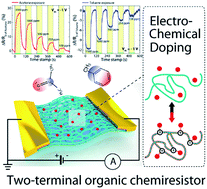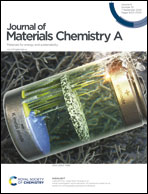Molecular-level electrochemical doping for fine discrimination of volatile organic compounds in organic chemiresistors†
Abstract
Printable organic sensors fabricated from solution-processed π-conjugated polymers (π-CPs) are promising candidates to detect volatile organic compounds (VOCs) due to the intriguing physical, chemical and electronic properties of π-CPs. These devices, often termed organic chemiresistors, require good sensing capabilities to transduce stimuli from specific VOCs at low concentrations into analytical electric signals. However, discriminating such VOCs using organic chemiresistors has proven very challenging. Herein, we report that the molecular-level electrochemical doping of π-CPs with solid-state ionic liquids (SILs) significantly improves their electrical conductivity (∼10−1 S cm−1) and selective VOC interactions, which can be manipulated through different π-CPs:SIL blend ratios. These characteristics enable the fine discrimination of VOCs at concentrations in the parts-per-billion (ppb) range under low power consumption (<0.1 μW) and room temperature conditions. Our result provides a new opportunity for developing highly sensitive and selective VOC monitoring platform technologies that are printable on large-area, wearable, flexible and transparent substrates.



 Please wait while we load your content...
Please wait while we load your content...